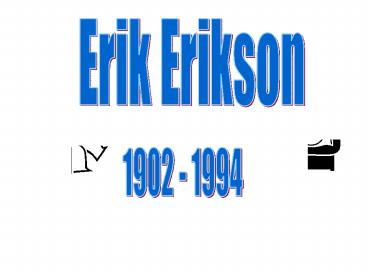Early Years - PowerPoint PPT Presentation
1 / 17
Title:
Early Years
Description:
Times New Roman Arial Tahoma Default Design Clip Slide 1 Early Years Early Years Early Professional Life Later Years Career Milestones Development of ... – PowerPoint PPT presentation
Number of Views:267
Avg rating:3.0/5.0
Title: Early Years
1
Erik Erikson
1902 - 1994
2
Early Years
- born in Frankfort, Germany, 1902
- didnt learn until later he was adopted by Dr.
Homburger - studied art
3
Early Years
- went to Vienna to teach - didnt even have a
college degree - studied psychoanalysis with Freud at the Vienna
Psychoanalytic Institute
4
Early Professional Life
- became a prominent child psychoanalyst (new
field) - moved to U.S. in 1933
- Bostons first child analyst
- position at Harvard
- taught at Yales Institute of Human Relations
- first important book published in 1950,
Child-hood and Society
5
Later Years
- professor at the University of California
- Returned to Harvard until 1970
- became Sr. consultant in psychiatry, Mt. Zion
Hospital, San Francisco - Died in 1994, age 92
6
Career Milestones
- was considered most influential psychoanalyst
alive - addressed identity, status of women,
developmental crises - learned from Freud, but expanded theory
7
Development of Psychosocial Stages
- used psychohistorical method - studied Hitler,
Kierkegaard, Gandhi - used therapy situation to acquire information and
check out ideas - ego identity is main area of concern
- ego is mainly unconscious
- stresses influence of culture and social
interaction - eight stages, each has a negative (crises) and
positive pole
8
Stage I Trust vs. Mistrust (Hope)Ages 0 to 1
Year Infancy
- infants need to feel cared for and loved
- trust within and without - trust of self as well
as others - rejected children are more fearful, insecure,
jealous, aggressive, hostile, isolated -
mistrustful
9
Stage 2 Self-Reliance vs. Self-Doubt
(will)Ages 1 to 3 Years Early Childhood
- awareness of emerging skills develops
- need to be taken seriously
- positive resolution includes acceptance of
negative feelings - rage, anger, hatred - as
well as independence
10
Stage 3 Initiative vs. Guilt (purpose)Ages 3 to
6 years Preschool Age
- child decides what kind of person to be
- initiative comes with freedom and opportunity to
initiate motor play and intellectual pursuits - guilt comes from being made to feel bad about
self-initiated activities and ideas
11
Stage 4 Industry vs. Inferiority
(competence)Ages 6 to 12 Years
School Age
- academic tasks reading, writing, math
- physical tasks sports, manual dexterity
- social tasks making friends, following rules,
sharing ideas - industry is orientation toward working, doing,
producing
12
Stage 5Identity vs. Role-Confusion (
fidelity)Ages 12 to 18 Years Adolescence
Teen
- time of psychological and physiological
revolution - firm self-image is formed
- must develop strong identity - sexual, personal
- time to select work goals, career
- lack of identity inability to progress
successfully
13
Stage 6Intimacy vs. Isolation (love)Ages 18 to
35 Years Early Adulthood
- intimacy is the ability to care deeply for
another person - the ability to share ones true feelings
- the ability to give and receive affection
- isolation leads to self-absorption and social
death
14
Stage 7Generativity vs. Stagnation (care)Ages
35 to 55 Middle Age
- become more aware of eventual death
- question life-style, goals choices
- motivation to have impact outside of family
- care represents concern for others and need to
give to next generation - stagnation reflects preoccupation with self only
15
Stage 8Integrity vs. Despair (wisdom)Ages 55 to
65 to death old age
- wisdom comes from a meaningful life
- integrity reflects the life well-lived
- with integrity, one can accept death
- despair reflects a wish to do it over correctly
- with despair, one does not find peace
16
Musical Video
- http//www.youtube.com/watch?v-i9ckfFRcd4feature
player_embedded
17
Handout 9-4 Items on the handout were derived
from Eriksons statements about each stage.
Scores for each subscale range from 0 to 15, with
high scores reflecting greater strength on a
particular personality dimension.
- Trust - The response to item 1 should be reversed
- (0 3, 1 2, 2 1, 3 0) and then added to
the numbers given in response to items 2, 3, 4,
and 5 - Autonomy - 7, 8, and 9 should be reversed and
added to items 6 and 10 to assess autonomy. - Initiative 12 and 15 should be reversed and added
to items 11, 13, and 14 to measure initiative. - Industry 16, 18, and 19 should be reversed and
then added to 17 and 20 to calculate industry. - Identity - 21 and 25 must be reversed and added
to 22, 23, and 24 - Intimacy - 26, 28, and 30 are reversed and added
to 27 and 29 - Generativity - Responses to 31 and 33 are
reversed and added to 32, 34, and 35 . - In both sexes, the authors found that the scores
on each dimension were related to an independent
measure of well-being.

